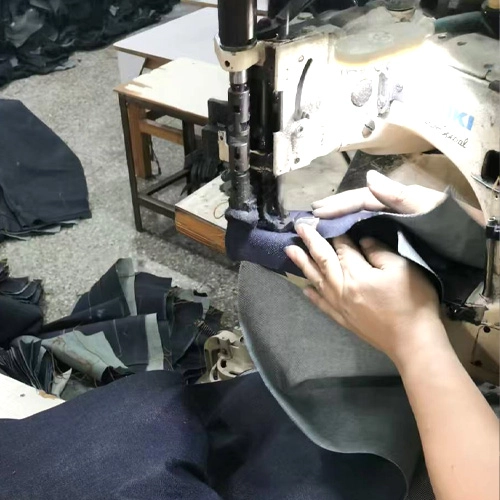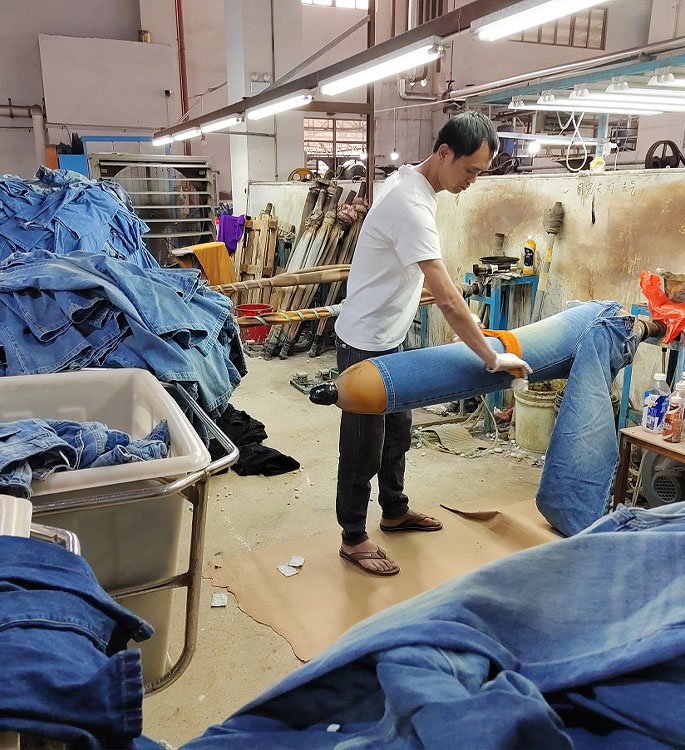Don't miss our holiday offer - up to 50% OFF!

How to customize denim clothing?
Denim clothing is more than just a fabric; it’s a blank canvas. In a world of fast fashion, customizing your denim clothing is a powerful way to express your individuality, breathe new life into old pieces, and create a wardrobe that is uniquely yours. The best part? You don’t need to be a professional designer to start.
This comprehensive guide will walk you through various methods to transform your jeans, jackets, and shorts from standard to spectacular, complete with inspiration from real-world fashion icons.

Why Customize Your Denim?
Before we dive into the “how,” let’s consider the “why.” Customizing your denim is sustainable, as it extends the life of your garments. It’s economical, saving you from buying expensive, one-of-a-kind pieces. Most importantly, it’s creative. It allows you to tell a story and wear your personality on your sleeve—literally.
Method 1: The Art of Distressing
Distressing is one of the most popular ways to add an edgy, worn-in character to denim. It involves strategically damaging the fabric to create rips, frays, and faded areas.
How to Do It:
- For Frayed Hems: Simply cut off the original hem of your jeans or jacket sleeves. Then, use a seam ripper, tweezers, or even a wire brush to pull out the horizontal white threads. Wash and dry the garment to encourage natural fraying.
- For Rips and Holes: Mark where you want the rips with chalk. Place a piece of cardboard inside the leg to protect the back. Use a utility knife or razor blade to make horizontal cuts. Then, use your tweezers to pull out the blue threads, leaving the white warp threads visible for that authentic ripped look.
- For Sanding/Fading: Use sandpaper (medium to coarse grit) or a pumice stone on areas that naturally crease, like the thighs, knees, and pockets. This will gently remove the top layer of indigo dye, creating a custom-faded effect.
Real Case Study: Hailey Bieber
Hailey Bieber is often spotted in heavily customized denim. She has taken simple, high-waisted jeans and created an array of knee rips, thigh slashes, and distressed hem details. Her look is a masterclass in balanced distressing—enough to be edgy, but not so much that it loses its structure.
Method 2: Embellishments and Embroidery
Adding embellishments is a fantastic way to make a bold, personal statement. This can range from subtle hand-stitched designs to lavish applications of patches, beads, and sequins.
How to Do It:
- Patches: Sew-on or iron-on patches are incredibly easy to use. Arrange them on your denim jacket or the back pocket of your jeans before committing. You can create a symmetrical layout on a jacket collar or a chaotic, “punk-rock” assortment on the back.
- Embroidery: You can hand-embroider simple designs like flowers, your initials, or celestial shapes using basic embroidery floss and a needle. For more complex designs, you can trace a pattern onto the denim with a water-soluble pen first.
- Beads, Rhinestones, and Studs: Use fabric glue or a hot-fix applicator for rhinestones. For studs and beads, you’ll need a needle and strong thread. Create patterns along the pockets, collar, or even outline the seams of your garment for a subtle sparkle.
Real Case Study: Dior S/S 2017
Maria Grazia Chiuri’s debut collection for Dior featured iconic denim jackets with the phrase “We Should All Be Feminists” embroidered on the back. This sparked a massive trend in statement embroidery, proving that denim can be a powerful medium for cultural and personal messages.
Method 3: Paint and Dye
If you want to make a truly radical change, fabric paint and dye are your best friends. This method allows for complete creative freedom, from abstract splatters to detailed illustrations.
How to Do It:
- Fabric Paint: Acrylic-based fabric paints are ideal. Use a brush for precise designs or a sponge for textured effects. You can also use stencils for a clean, repeatable pattern. Always remember to place a piece of cardboard inside your garment to prevent bleed-through.
- Bleach Dyeing: For a reverse effect, you can use bleach to remove color. Create patterns by spraying, dipping, or using a tie-dye technique with bleach (always in a well-ventilated area and wear gloves!). Once you achieve the desired level of lightness, neutralize the bleach by rinsing the garment in a mixture of water and hydrogen peroxide, then wash it thoroughly.
- Dip-Dyeing: Create an ombré effect by dipping the hem of your jeans or the sleeves of a jacket into fabric dye. The longer you leave it in, the darker the color will become.
Real Case Study: Levi’s® x New Balance “Miami Drive” 990v5
While a sneaker collaboration, this project is a perfect example of paint customization. Artist Dr. Romanelli customized New Balance 990v5 sneakers with Levi’s denim, hand-painting them with vibrant, Miami-inspired colors and patterns. This demonstrates how paint can transform a denim-based item into a wearable work of art.
Method 4: Structural Changes and Reconstruction
For the advanced customizer, changing the very structure of a garment offers the ultimate challenge. This involves cutting, sewing, and reconstructing pieces into something new.
How to Do It:
- Cropping: Turn a long-sleeve denim shirt into a short-sleeve one, or transform bootcut jeans into trendy cropped straight-legs. Always measure twice and cut once!
- Patchworking: Combine scraps of different denim washes and colors to create a unique patchwork garment. This is a great way to use old jeans that are beyond repair.
- Creating Something New: An old pair of jeans can be deconstructed and turned into a crossbody bag, a bucket hat, or even a vest. Let your imagination run wild.
Real Case Study: Marine Serre
The French designer Marine Serre is renowned for her “upcycled” collections, where she often deconstructs vintage denim and reworks it into entirely new, high-fashion garments. While complex, her work inspires the idea that an old pair of jeans isn’t waste—it’s raw material.
Getting Started: Your Customization Toolkit
You don’t need a lot to begin:
- A denim piece (jacket, jeans, shorts)
- Scissors, seam ripper, and tweezers
- Sandpaper or a pumice stone
- Needles and strong thread
- Embroidery floss
- Patches, studs, beads
- Fabric paint and brushes
- Chalk or a water-soluble pen for marking
Start small. Personalize the back pocket of your jeans with some embroidery or add a single patch to your jacket’s sleeve. As you gain confidence, you can tackle more ambitious projects. Remember, the goal isn’t perfection; it’s personality. So grab your denim and start creating your own fashion story today
